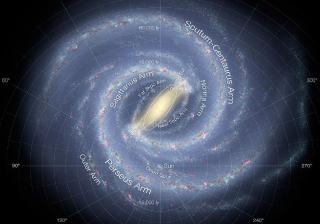Bibcode
González-Fernández, C.; López-Corredoira, M.; Amôres, E. B.; Minniti, D.; Lucas, P.; Toledo, I.
Bibliographical reference
Astronomy and Astrophysics, Volume 546, id.A107
Advertised on:
10
2012
Journal
Citations
21
Refereed citations
20
Description
Context. The VISTA Variable Survey (VVV) is able to map the Galaxy at l
≤ 0° with an unpaired depth (at least 3 mag deeper than 2MASS),
opening new possibilities for studying the inner structure of the Milky
Way. Aims: In this paper we concentrate on the exploitation of
these data to better understand the spatial disposition and distribution
of the structures present in the inner Milky Way, particularly the Long
Bar and its interaction with the inner disc. Methods: To attain
this, we present the Ks vs. J - Ks diagrams obtained with VVV of regions
with (-20° < l < -8°, |b| < 2°). From them we
derive the distribution of red clump giants with heliocentric distance
as a proxy for the overall stellar structure of the Galaxy. Along with
these diagrams, we analysed the distribution of photometrically selected
red supergiants, in order to detect events of recent stellar formation.
Results: The observations show the presence of a clear
overdensity of stars with associated recent stellar formation that we
interpret as the traces of the Long Bar, and we derive an angle for it
of 41° ± 5° with the Sun-Galactic centre line, touching
the disc near l = 27° and l = -12°. The colour-magnitude
diagrams presented here also show a lack of disc stars in several lines
of sight, a fact that we associate with the truncation of the disc by
the potential of this bar for RGC ≤ 5 kpc.
Appendix A is available in electronic form at http://www.aanda.org
Related projects

Morphology and dynamics of the Milky Way
This project consists of two parts, each differentiated but both complementary: morphology and dynamics. Detailed study of the morphology of the Milky Way pretends to provide a data base for the stellar distribution in the most remote and heavily obscured regions of our Galaxy, through the development of semiempirical models based on the
Martín
López Corredoira